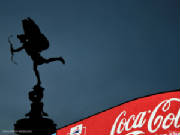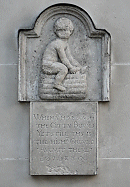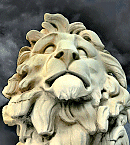|
Boudicca
The British warrior queen,
wife of Prasutagus, king of the Iceni, a people inhabiting what is now Norfolk and Suffolk. On her husband’s death (AD
60) the Romans seized the territory of the Iceni. The widow was scourged for her opposition and her two daughters raped. Boudicca
raised a revolt of the Iceni and Trinovantes and burned Camulodunum (Colchester), Londinium and Verulamium (St Albans). According
to most sources, when finally routed by the Roman governor Suetonius Paulinus, she took poison. As ‘Boadicea’,
she is the subject of poems by William Cowper and Tennyson. One legend has it that she is buried beneath a platform at King’s Cross station. A tumulus near Parliament Hill was also said to be her burial place, but when it was excavated in 1894 little was
found except signs that it had already been dug out before. It is said that, if confirmation had been found, Thomas Thornycroft’s
statue of the queen in her chariot would have been erected at that spot, instead of its present site at Westminster Bridge.

Day
A once-controversial sculpture (1929) by Jacob Epstein (1880–1959)
on the exterior of 55 Broadway. The building is graced by ten reliefs, none of which was much appreciated at the time of its
construction, including Epstein’s companion piece to Day, Night, and works by Eric Gill and Henry
Moore. However, public and press opprobrium centred on Day for its portrayal of a father and his naked son and, in
particular, for the proportions of the boy’s phallus. Frank Pick, ‘the man who built London Transport’ and
commissioned the work, stood by Epstein and threatened to resign rather than remove the sculpture but Epstein deflected the
criticism by ascending the building one night and reducing the length of the offending appendage by 1½ inches (3.8 cm).

Elfin Oak
A tall, thick tree stump
situated next to the children’s playground on the north side of Kensington Gardens. It was brought here from Richmond Park in 1928 and decorated with carvings of fairytale creatures by the children’s book illustrator Ivor Innes. It has since
been restored several times, notably with the help of the comedian Spike Milligan, and is now protected by a cage. The oak
was awarded grade II listed status in 1997.
Eight hundred years ago, when Stephen was King of England, this
tree began to grow, in a great forest, where now is Richmond Park. And when it had grown for hundreds of years, and become
huge and gnarled and knotty, the Little People began to inhabit it.
Elsie Innes: The Elfin Oak of Kensington Gardens
(1930)

Eros
The popular name for the winged
archer in the centre of Piccadilly Circus, which was actually intended to represent the angel of Christian charity. A memorial
to the 7th Earl of Shaftesbury, it is the work of Sir Alfred Gilbert (1854–1934) and was unveiled in 1893.

Golden Boy of Pye Corner
A gilded
statue of a naked, and somewhat chubby, little boy, situated at the corner of Giltspur Street and Cock Lane, in Smithfield.
This is the spot where buildings were blown up to halt the Great fire of London and the inscription beneath the boy blames
the fire on the sin of gluttony. The statue was set into the wall of the Fortune of War, a public house frequented by body
snatchers in the 1820s. The pub was demolished in 1910 and the City & Guilds building now occupies the site.
Naked Lady
The colloquial name
of La Délivrance, a bronze statue of a naked women holding a sword aloft, located at Henly’s Corner, on the
North Circular Road. The work of the French sculptor Emile Guillaume (1867–1942), it was inspired by the allied victory
at the First Battle of the Marne, which delivered Paris from the threat of German seizure in 1914. The statue was exhibited
at the 1920 Paris Salon, where it was bought by the newspaper magnate Lord Rothermere, who donated it to Finchley council
in honour of his mother, a resident of Totteridge. Lloyd George unveiled the statue in October 1927 before a crowd of 8,000.

Panyer stone
A stone relief bearing
what Dr Brewer called ‘a rude representation of a boy sitting on a pannier’. It was originally let into a building
on Panyer Alley, a narrow passage that led off Newgate Street, and commemorated the Panyer Boy, an inn burnt down in the Great
Fire of London. In the Middle Ages the alley was a popular standing place for boys selling bread from baskets. The stone,
which is dated 1688, has been moved more than once because of rebuilding and is presently embedded in a wall beside the southern
entrance to St Paul’s station. An inscription claiming that the ground is the highest point in the City has never been
quite true of any of its locations.
A remarkable conspiracy was detected by the authorities of the City a
few days ago, when an attempt was made to steal the celebrated Panyer stone … It appears that a rich American bribed
one of the workmen, engaged in pulling down the old warehouse in which the stone is fixed, asking him to exchange the old
relic for a modern stone, and promising to pay £50 for the deception. The workman conveyed notice of this to the City authorities,
and a guard has now been placed upon the original stone, which is a cherished heirloom of the City.
The Echo (21 January
1893)
quadriga
A contraction of quadrijugae
(Latin quadri-, ‘four’, and jugum, ‘yoke’). In classical antiquity, a two-wheeled
chariot drawn by four horses harnessed abreast. The Wellington Arch at Hyde Park Corner is surmounted by a fine bronze group,
Peace Descending on the Quadriga of War, executed by Adrian Jones in 1912. The cost of the sculpture was met by Herbert
Stern, 1st Baron Michelham (1851–1919), whose 11-year-old son Herman served as a model for the boy who pulls at the
reins of the four horses harnessed to the quadriga as a huge figure of Peace descends upon them from heaven.

South Bank lion
A 13-ton Coade
stone lion that from 1837 stood on a parapet of the Lion Brewery on the South Bank. It is the work of the sculptor W.F. Woodington
(1806–93). The brewery was demolished in 1950 to make way for the construction of the Royal Festival Hall but the lion
was saved, reportedly at the request of George VI, painted gloss red and mounted on a plinth outside the Waterloo Station
gate to the Festival of Britain site. When the station was enlarged in 1966 the lion was relocated to its present prominent
position near the eastern end of Westminster Bridge, and stripped to the bare stone.
Temple Bar
A location at the point
where Fleet Street becomes the Strand, marking the western limit of the City of London. A barrier is first recorded here in
the late 13th century (barram Novi Templi). This seems to have been nothing more than a chain between two posts,
but by the middle of the 14th century there was an arched gateway here, with a prison on top. This survived the Great Fire
of london, but was nevertheless demolished, and a new one was erected in the 1670s to a design by Christopher Wren. In the
late 17th century it became the practice to display the heads of traitors impaled on spikes on top of the gate (it was quite
a high gate, and those who wanted to get a better view could hire a telescope for a halfpenny). The last shrivelled head apparently
fell off c.1772. By the middle of the 19th century Temple Bar’s central arch was becoming too much of an impediment
to traffic, and in 1878 it was removed. It was later re-erected in Theobalds Park, Hertfordshire, where it remained for more
than a hundred years. In 2004 it was returned to the City, incorporated into the Paternoster Square redevelopment. While the
arch itself has gone, its location retains its symbolic significance: a sovereign who wishes to enter the City via Fleet Street,
typically on his or her processional way to St Paul’s Cathedral, must stop here and ask permission of the lord mayor
of London. The line is marked by a memorial in the centre of the road, erected in 1880, and surmounted by a dragon that is
frequently misidentified as a griffin.
|

